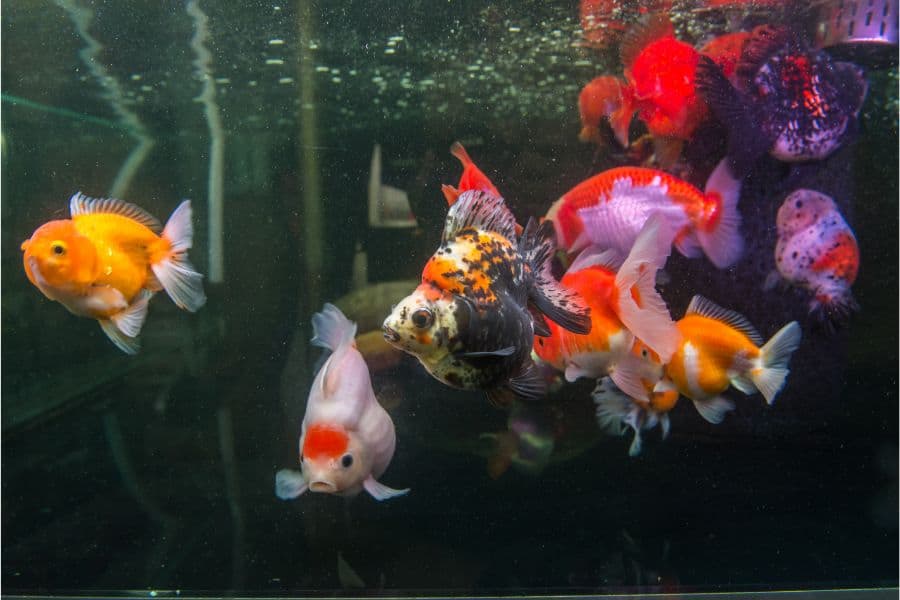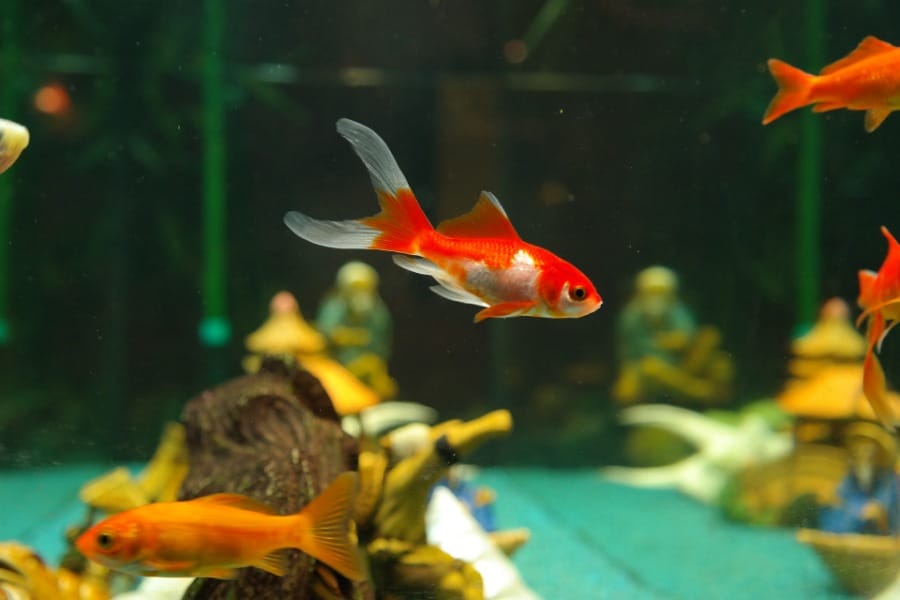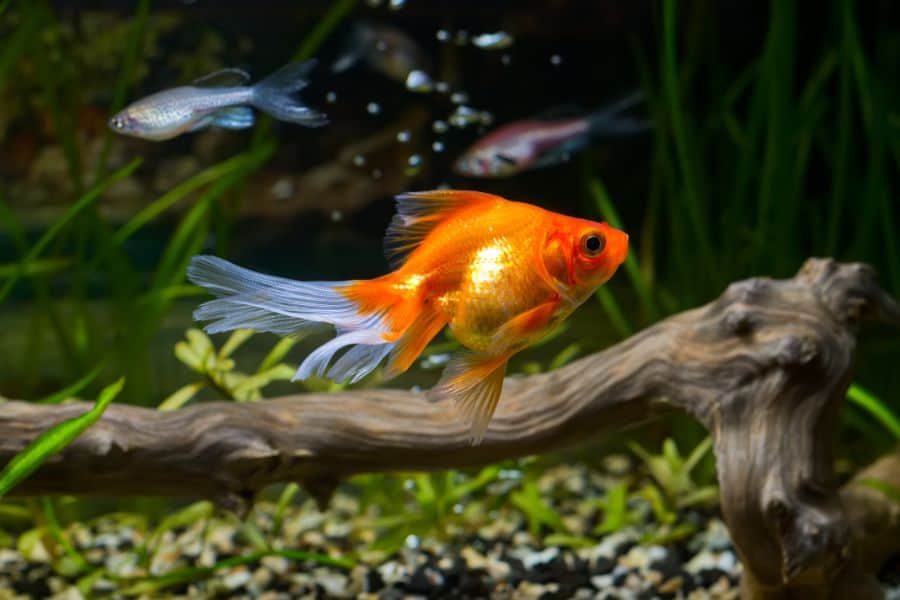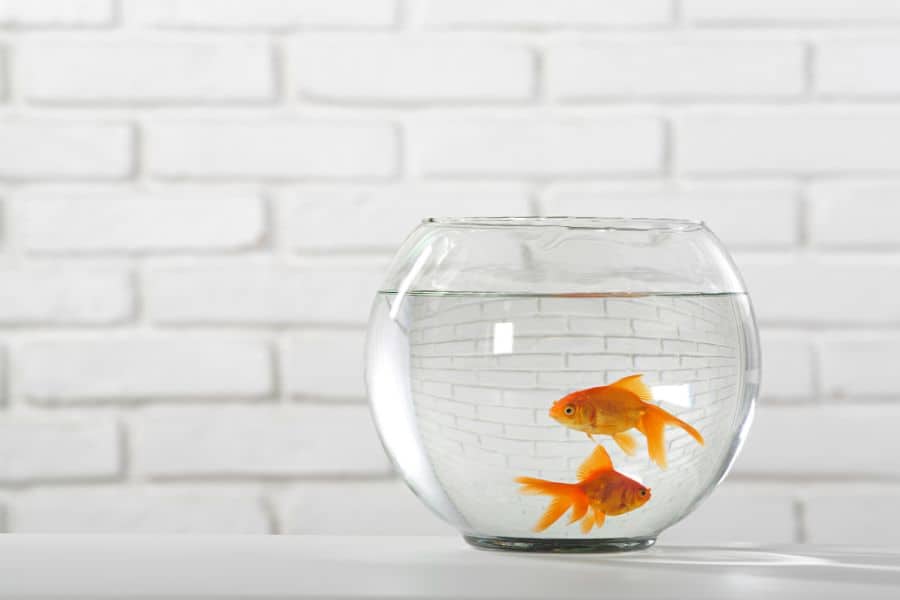Have you heard of the “one gallon per inch of fish” rule? This rule is completely bogus! This rule may apply to some small fish species, but certainly not goldfish.
Unfortunately, many people still insist that it’s acceptable to keep goldfish in a tank as little as 10 gallons. Others would even keep a group of goldfish in such an uncomfortably confining tank. This willful ignorance will only hurt the long-term thriving capabilities of the fish.
On the other hand, you’ll see some aquarists keeping two or three fancy goldfish in a colossal tank. What gives? Is it because they can afford to shell out that much money? Is this too much than what’s required?
AC Aquarium aims to dispel your doubts, answer as many questions as possible, and debunk popular myths and misconceptions.
This article will guide you to find the right tank size for your goldfish. We will discuss why bigger is better!
Goldfish Tank Size: Factors to Consider
While there are a couple of factors to take into account, I’d like to explain three of the most important considerations.
Type of Goldfish
Did you know there are more than a hundred varieties of goldfish? Before you take goldfish as pets, you need to do some digging.
Goldfish have different levels of care requirements. Some fish can be beginner-friendly, while others demand years of expertise to thrive — not to mention, a chunky portion of your budget.
First, let’s look at the Common goldfish and Comets. These goldfish will endure poor conditions for as long as they can.
These fish are so resilient that if people dump them into the wild, they can survive frigid waters by entering into torpor throughout the winter. Before you know it, they will grow into the size of a football and become an invasive species in your area.
In home aquariums, you can see them housed in small groups of three or five. Some hobbyists keep a pair in a community tank. Either way, you’ll often hear how these fish are doing just fine in their humble tanks.
On the other hand, fancy goldfish are less tolerant of lapses in the water parameters. Some fancy goldfish varieties, such as Oranda and Celestial Eye, are even more sensitive than others.
That is why if you observe how seasoned aquarists care for their fancy goldfish, you’ll notice how they always keep their prized pets in gigantic tanks. To err on the side of caution, most aquarists keep just one or two fancy goldfish in a tank.
The main reason? Dilution of pollution.
The fewer fish and the bigger the volume of water you keep, the more leeway you get bioload-wise. Water chemistry and temperature will remain more stable, as well.
My point is, what applies to other goldfish doesn’t apply to the rest, and this includes tank size. Unfortunately in this digital age, wrong information is easily disseminated.
I cannot stress enough how important it is to know a species better before you decide to take one home!
Potential Size
“Goldfish grow to the size of their container” is one of the classic misconceptions shared across the Internet. Surprisingly, there is some truth to this claim.
Common goldfish in as little as five gallons may remain at a manageable size and live for a couple of years.
Goldfish are among the many fish species capable of conditioning the surrounding water. The species emit growth-inhibitory hormones like somatostatin to suppress the development of other fish.
In a crowded tank, this mechanism aims to reduce intraspecific competition among them. Well, aren’t goldfish smart and sly?
In a natural environment, currents dilute or wash away these hormones. But in a closed system, like an aquarium, hormones accumulate in the water quickly and suppress the goldfish itself.
Now, you might be wondering: what if the tank isn’t crowded with fish?
Cramped conditions will still cause many problems and inhibit the growth of your solitary goldfish.
Muscle atrophy is among these problems. Your fish is unlikely to develop muscle tone and bulk as it would if it had adequate space to swim.
No matter how you look at it, a stunted fish is never a healthy, happy fish!
Understand that the same hormones responsible for keeping your fish stunted are likewise responsible for delaying reproduction and a robust immune system.
Astoundingly, some individual goldfish continue to grow even in chronic stress situations. This is particularly true for long-bodied, single-tailed goldfish resembling their carp ancestors.
As mentioned earlier, these kinds of goldfish will grow to massive sizes. That’s why people release them in open lakes if they can’t rehome them in large quarters.
Scientific studies lack answers to why this survival potential is non-existent in fancy goldfish, especially newer varieties.
It is impossible for fancy goldfish to survive in tiny accommodations. I guess “fancy” is a fitting moniker because these fish demand quite a lot of work to keep in good condition.
Tank Mates and Recreation
According to some, goldfish are dumb and have a measly three-second memory span. However, these claims are untrue!
Goldfish can tell their owners apart from others. These water piggies can take cues when it’s time to eat and swim to you to receive their long-awaited rations.
Inquisitive and playful, you can even train goldfish to play simple games.
Goldfish are social, gregarious fish. Studies have shown that goldfish benefit from living in groups and based on first-hand experience, they socialize even with other goldfish breeds.
That is why you should get a spacious aquarium, so you can keep at least a pair and provide them some sort of recreation without compromising space.
Related: Ideal Tankmates for Your Goldfish
What Is Goldfish Grooming? How Big of A Tank Do You Need?
In the aquatics hobby, grooming ornamental goldfish means you raise your fancy goldfish to its absolute potential.
In Asia, where goldfish beauty pageants are prevalent, grooming is what you do not only to get your fancy goldfish looking its best but also to enhance the unique characteristics a certain breed was developed for.
The criteria for judging also include the health of the fish, how it swims and how it holds its body in the water, its personality, and responsiveness, among other things.
Different breeds require slightly different techniques for grooming. But if anything, groomers agree on one thing, and that’s to get the largest tank you can possibly afford.
The tank size is inarguably one of the biggest factors that influence the effectiveness of goldfish grooming.
Simply keeping fancy goldfish as a hobby means you won’t have to focus on other aspects beyond healthy feeding and correct water parameters the way someone hoping to groom champions would.
But if you want to groom your fish, you’d definitely look for a larger aquarium than what is recommended in the table below.
For fancy goldfish not exceeding 10 inches, I recommend at least 50 gallons for one fish or 125 gallons for two to three fish. Understand that’s just the minimum. If you can go for 225 gallons, kudos to you!
If you aren’t grooming your fish, you can follow the 25-gallon per fish rule.
Recommended Tank Size for Goldfish
When keeping goldfish in an indoor tank, you’ll want to follow the guidelines below to avoid stunted growth and ensure your fish becomes a picture of health. Take note; minor variations may happen in every breed of goldfish.
| Name of Goldfish | Average Size (Adult Male) | Tank Size for 1 Adult Fish |
| Common or feeder fish | 12 inches, often bigger | 50 – 75 gallons |
| Comet | 12 inches | 50 – 75 gallons |
| Oranda | 8 – 9 inches | 25 gallons |
| Ryukin | 4 – 6 inches | 25 gallons |
| Ranchu (Maruko/King of Goldfish) | 6 – 8 inches | 25 gallons |
| Lionhead (precursor to the Ranchu) | 6 inches or slightly bigger | 25 gallons |
| Shubunkin | 12 – 18 inches | 50 – 75 gallons |
| Pearlscale (Chinshurin) | 4 inches | 25 gallons |
| Bubble Eye | 3 – 4 inches | 25 gallons |
| Telescope | 4 – 10 inches | 25 gallons |
| Veiltail | 6 – 7 inches | 25 gallons |
| Fantail | 6 – 8 inches | 25 gallons |
| Celestial Eye (Choutengan) | 5 – 6 inches | 25 gallons |
| Tamasaba (Sabao) | 10 inches, sometimes bigger | 40 – 50 gallons |
| Pompom (Hanafusa) | 4 – 6 inches | 25 gallons |
| Tosakin | 6 – 8 inches | 25 gallons |
| Butterfly Tail | 6 – 8 inches | 25 gallons |
| Wakin | 10 inches, sometimes bigger | 40 – 50 gallons |
| Watonai | 10 – 12 inches | 40 – 50 gallons |
| Jikin (Rokurin) | 8 – 10 inches | 40 – 50 gallons |
| Nymph | 8 inches, sometimes bigger | 40 – 50 gallons |
| Izumo Nankin | 4 – 6 inches | 25 gallons |
| Siamese Doll | 4 – 5 inches | 25 gallons |
While fancy goldfish don’t grow quite as huge as common goldfish, the genetics and bloodline of your fish may cause them to grow bigger than what is usually expected of them, and this holds true if you groom your fish.
Opt for a larger tank than what is recommended to give your fish more wiggle room. After all, it is always best to err on the side of caution.
If you wish to keep a bunch of common goldfish, Comets, Shubunkins, and other larger varieties of goldfish, a pond is the best place to do it.
True or False: Goldfish Can Live in A Bowl?
By the Tang Dynasty, the goldfish has become a symbol of affluence among Chinese aristocrats. Likewise, it symbolizes luck and fortune in Chinese Feng Shui.
As such, people would brag about their goldfish during banquets and present them in a small porcelain bowl, which is the predecessor of the glass bowl.
Yes, the idea of keeping goldfish in a bowl does originate from the Chinese. But after the Chinese aristocrats show off their prized goldfish, the servants would reintroduce them back into their colossal ponds.
Unfortunately, Europeans mistook the bowls for being the main habitat of the fish, rather than vessels used to show them off for a limited time.
Imports to Europe started in the 17th century. From around the late 1800s, it became a recurring subject in the works of legendary artists, including Neoclassical painter Charles Edward Perugini and Fauvism painter Henri Matisse.
Glittering goldfish in glass globes have become a popular parlor ornament among fashionable Victorians, and it didn’t take long for Americans to notice their mystique and follow suit.
It wasn’t until the Internet became more accessible to the broader public that people started sharing information and correcting each other’s mistakes.
Now, the question is — can goldfish live in a bowl? Absolutely not. Those who did, lived only for a while.
Now, some people might disagree and even bring up George, Goldie, and the Guinness Record Holder Tish. These stunted goldfish lived at least 40 years in their tiny tanks. Since these fish can, yours can, too, right? Not really.
Many factors play a pivotal role in longevity, and this includes genetics. Know that every single one of these fish is your typical feeder fish, which is closer to their hypoxia-tolerant ancestor — the Crucian carp.
Genetics aside, imagine living all your life alone in a room no bigger than a bathroom; it is no different for your fish. Your fish would be singing the same song in the 1983 cartoon, The Little Goldfish:
“So sad and alone in his little glass home. Just as lonesome as he can be. There’s a little goldfish whose only wish is a longing to be free…”
Keeping fish in fish bowls is old-fashioned and inhumane; it should be used for decoration or terrariums, not for keeping fish. Many problems arise, and ultimately they all boil down to size.
Also Read:
Wrapping Up
Humans often confined aquatic pets to ridiculously small spaces. Consider the effects of the lockdown on us. I can’t imagine how it would be different for another living creature. Can you?
Ethical, responsible fishkeeping means you will adhere to the requirements of the fish. Your goldfish should not be bound by the parameters you deem acceptable or attainable at the time.
Contrary to popular belief, keeping goldfish is not as easy as people thought it would be, and choosing the correct tank size is just the tip of the iceberg.
I hope you find this article helpful. I trust that you want your fish to thrive, not just survive.



